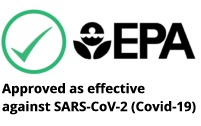Electrolysed Water
What is Electrolysed Water?
Electrolysed water is produced by the electrolysis of ordinary tap water containing dissolved salt (sodium chloride) to produce a solution of hypochlorous acid (HOCI) which can then be used as a disinfectant.
>99.05% Water, <0.04% Hypochlorous Acid, <0.01% Sodium Chloride
Totally natural, non-toxic and completely safe for human use, electrolysed water is already in use throughout many industries such as healthcare, food safety, water treatment and for general sanitation purposes. Hypochlorous acid is in fact naturally produced by white blood cells in mammals for healing and protection purposes.
Electrolyzed water has been used in the medical field for over a century. Before antibiotics were available, electrolyzed water was used to irrigate and disinfect wounds in World War I. The main challenge of using this disinfectant has been keeping it in a stable form for use as a disinfectant. This challenge was overcome in the ‘70’s and electrolyzed water is now used in hospitals, commercial laundries, swimming pools, cruise ships, water treatment, livestock farming and even produce sections in grocery stores.
Recent publications on the fight against the COVID-19 virus have also cited electrolyzed water as “a powerful natural tool for killing bacteria and viruses”.
Electrolyzed Water Disinfectants are:
- a powerful oxidant that kills 99.99% of bacteria, fungi, and viruses
- approximately 50 to 100 times more effective than household bleach, with faster reaction rates
- a weak acid similar to a mild citrus juice, therefore nontoxic and does not leave residue on environmental surfaces
- safe for human tissues and is made naturally by white blood cells in all mammals for healing and protection
- used in healthcare, food safety, water treatment, and general sanitation
How does it work?
Pathogens have charges, much like magnets. HOCI has a neutral charge enabling it to attach to germ surfaces which carry a negative electrical charge.
Electrons are removed through oxidation which disrupts the cellular structure of pathogens destroying the cell walls of bacteria and protein coats of viruses. The low molecular weight of the disinfectant solution makes it effective in penetrating the cell walls and protein coats allowing it to react faster and destroy the DNA and RNA inside of bacteria and viruses, thereby inactivating them.
How effective is it?
Studies have shown electrolysed water to be 50 to 100 times more effective than chlorine bleach at killing bacteria and viruses upon contact.
Contact is key, it relies on this for its efficacy as a disinfectant. Within a matter of seconds, it can oxidize the bacteria, unlike bleach which could take up to half an hour to do the same, whilst also being gentle on the skin.
When compared with alternative disinfectants, electrolysed water is not only more effective it is also much safer for human use.
Impact on the environment
Electrolyzed water is non-toxic and non-flammable and therefore does not require hazardous or chemical storage or handling precautions. Nor any special shipping or export requirements. Electrolyzed water has no toxic material disposal requirements and is not considered by OSHA to be hazardous waste adding yet another advantageous element.
This development seems especially fitting amidst growing concerns about eco-persistence of synthetic chemicals, and antimicrobial resistance trends amongst newly resurgent agents of disease. Further, during use, electrolyzed water does not harm surfaces, metals, clothing or wood. It is even used in the food industry as it does not leave any residue or change the taste of food.
Most fabrics can be completely submersed in a solution of highly concentrated electrolyzed water disinfectant and will not suffer damage by corrosion or bleaching.

